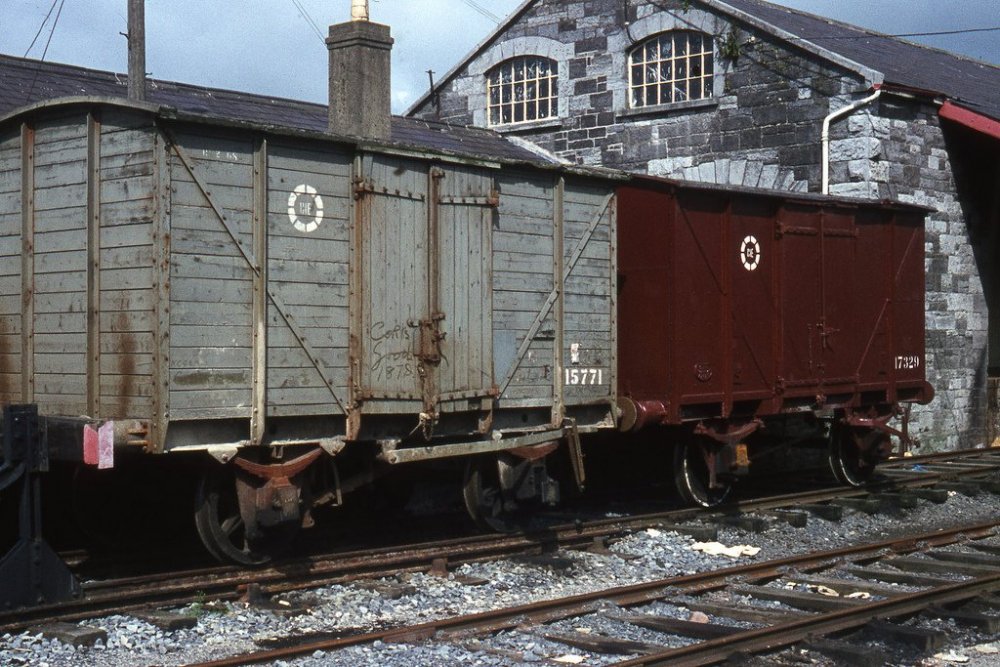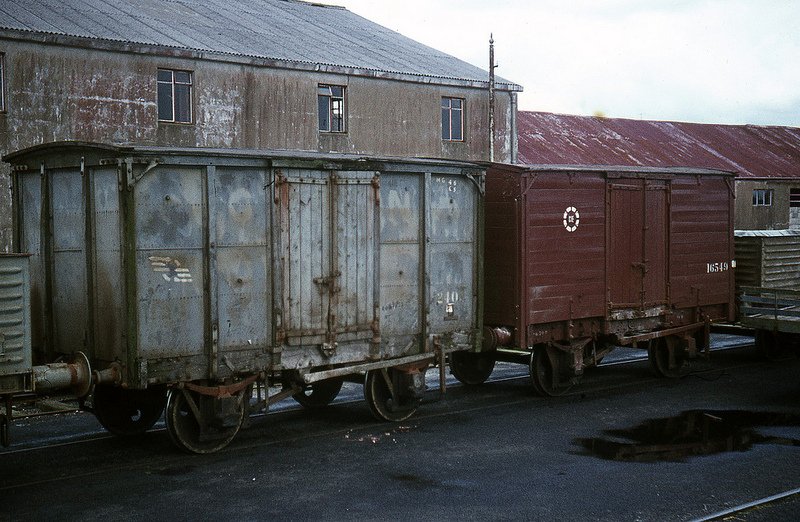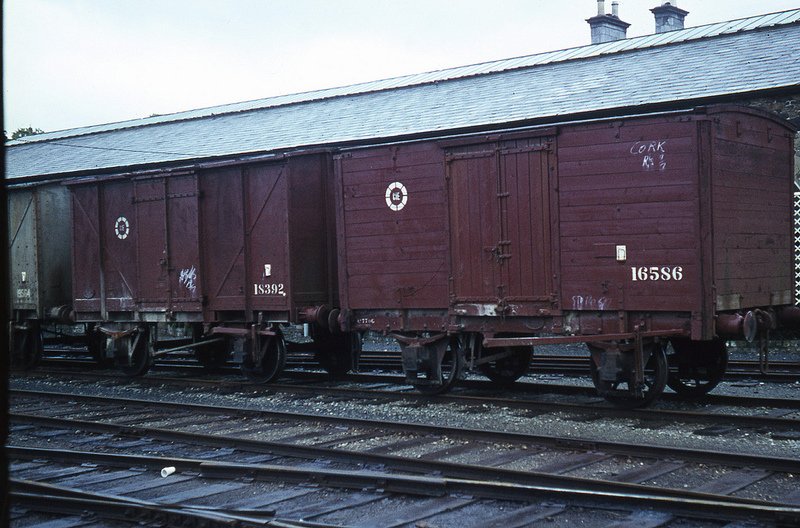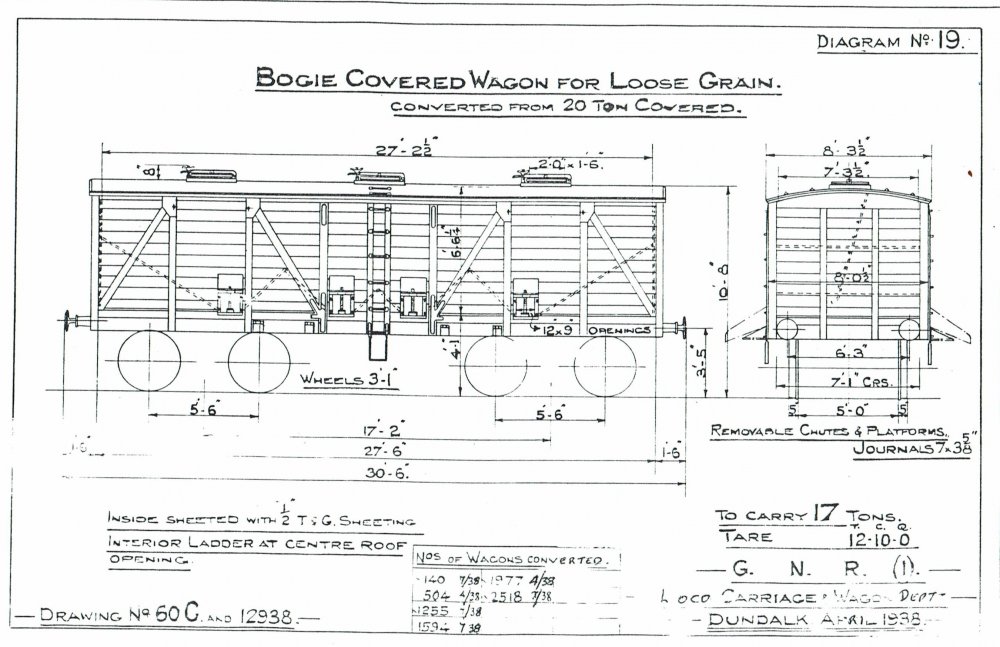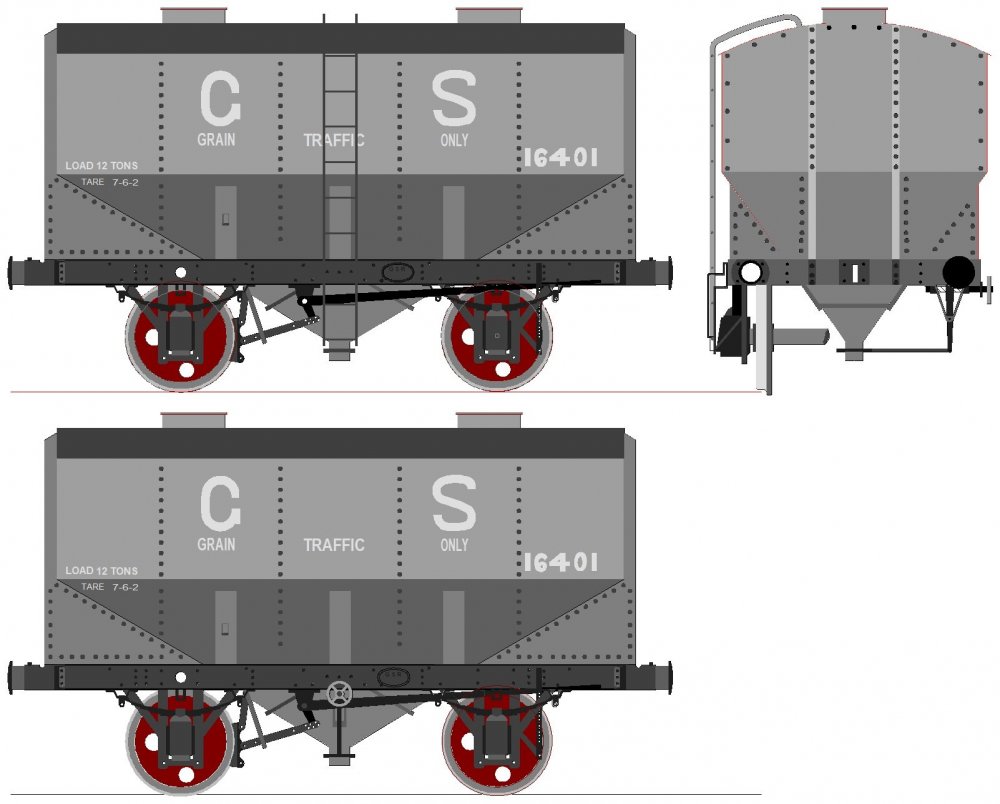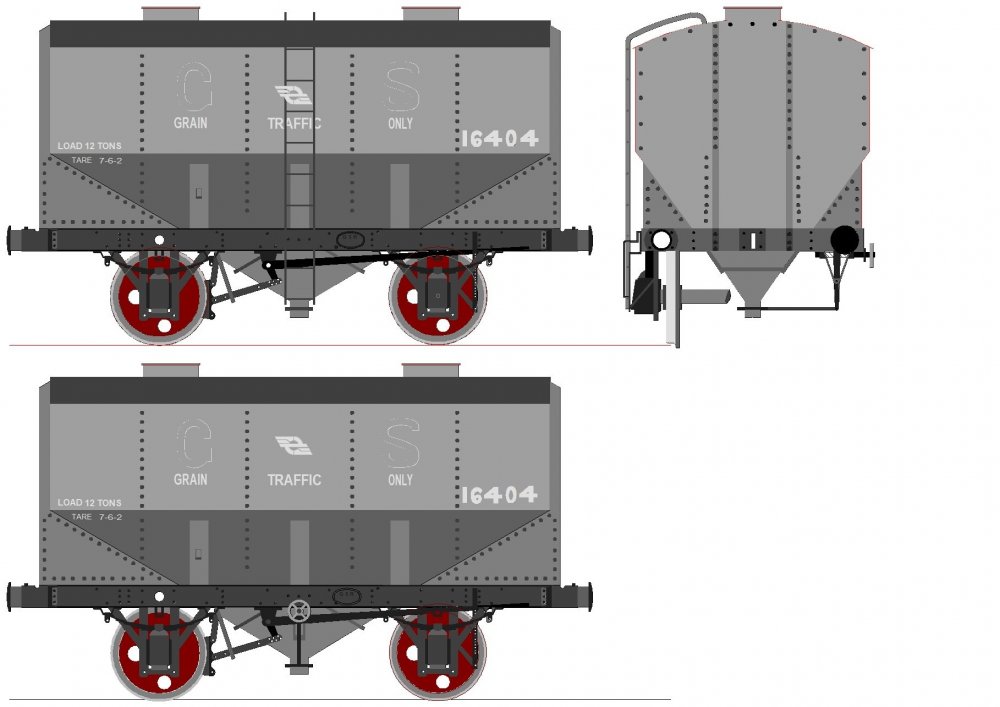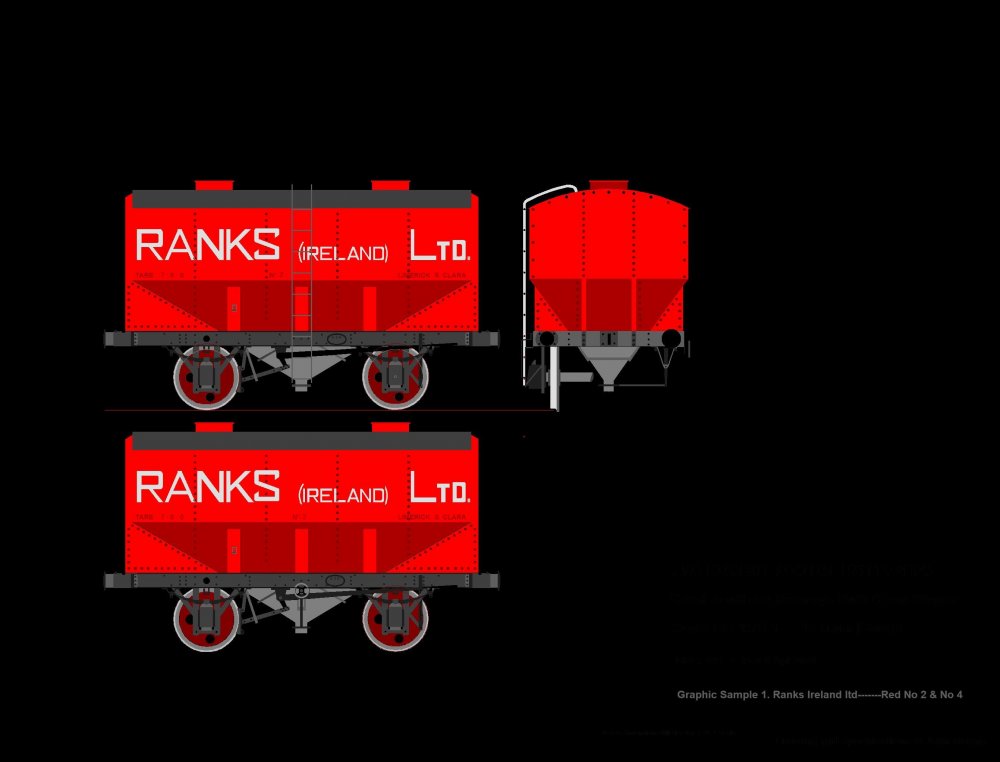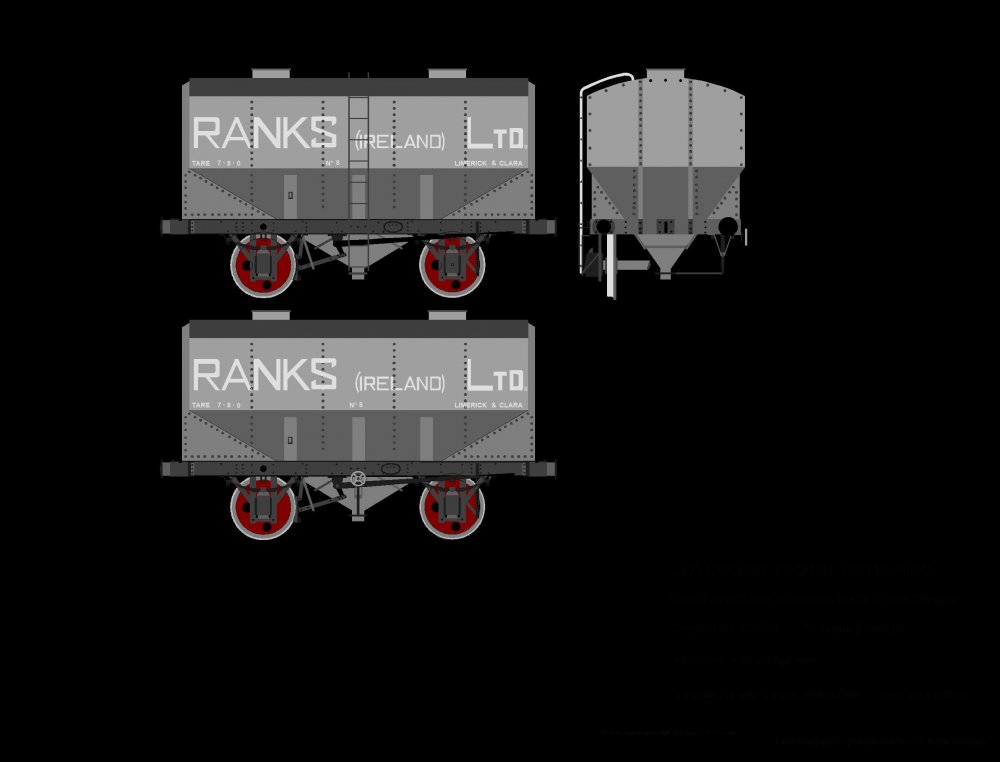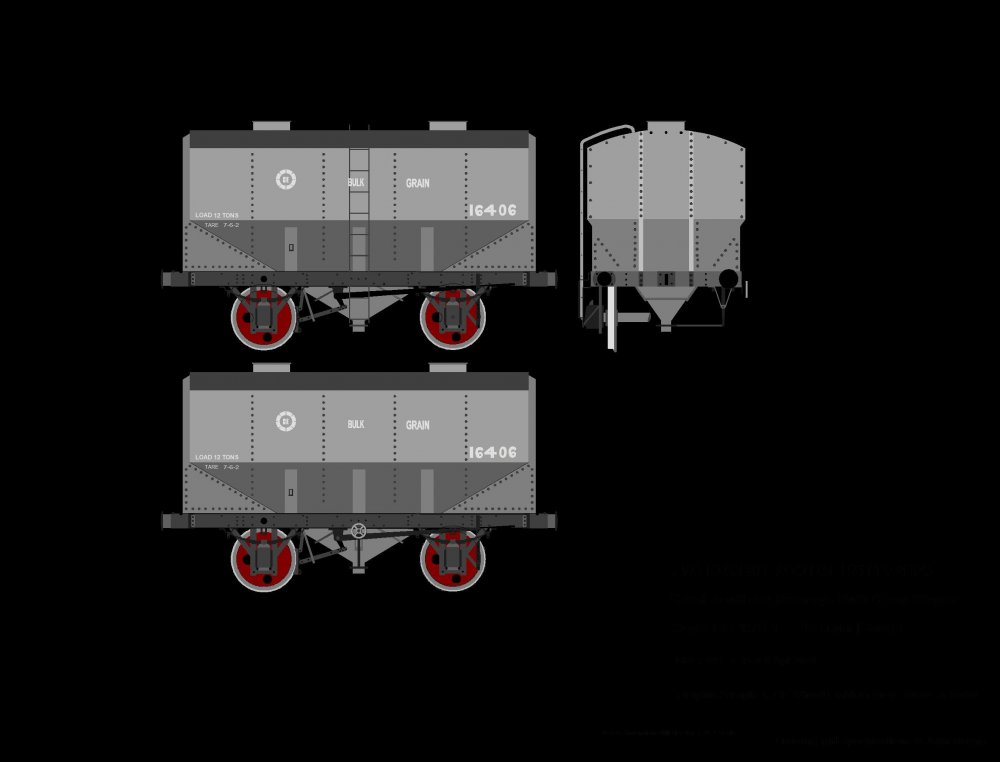-
Posts
4,855 -
Joined
-
Last visited
-
Days Won
119
Content Type
Profiles
Forums
Events
Gallery
Blogs
Store
Community Map
Everything posted by Mayner
-
The Lima Irish N Gauge steam loco and passenger coaches were British outline models in CIE livery introduced in the late 70s early 80s. The Lima coaches and wagons were reasonable models by the standards of the time, but I would not recommend the locos if you want a working model. The motor, traction tyre and power pick up system was pretty poor and would cease to run reliably or haul anything after a couple of weeks use. I replaced the tender drive in a Lima o-6-0 with the chassis from a Fleischmann 0-6-0 diesel shunter which transformed the running and haulage ability.
-
Possibly a proposal a late 1940s proposal for a light axle load branch line loco for Brazil, Australia or possibly CIE. A number of CIE board members and senior managers visited American in the mid-1940s no doubt visiting General Motors and the returned convinced of the benefits of replacing steam with diesel. The BL2 design was dead end and quickly replaced with the GP7 the first of the classic General Motors Road Switchers or General Purpose locos. The Brazilian locos appear to be mainly standard American domestic and export designs https://en.wikipedia.org/wiki/Category:Diesel-electric_locomotives_of_Brazil. Victoria preferred locally assembled GM types. South Australia a mixture of locally assembled Alco & English electric types. 600hp was a fairly common power rating for branch line and secondary work during the 1940s and 50s, Clyde Engineering introduced a 600hp version of the EMD GL8 type for shunting and branch line use in Victoria and Western Australia during the 1960s
-
Slight change of plan a 5m LED flexible light strip was simpler to install and easier on the pocket than buying several 324mm strips. The new light strip is brighter at 970 Lumens but is not over whelming for normal viewing, and provides adequate illumination on a dull day or when the room lighting is off. Its now possible to achieve a reasonable depth of field in a photo using a tripod without additional lighting. The swans have returned to the waterway and the photographers have pulled up to take a picture of the passenger special! More Tralee & Dingle in atmosphere than C&L, I am planning to develop a farm entrance scene here with more elaborate gates and semi low relief farm buildings on the back scene.
-
David you can relax with 659 according to the "Bible" (GSR Locomotives by Clements & McMahon) she ran with a Y superheated boiler between 1932 & 1950s, before reverting to a round topped boiler, so its just about possible the loco received yellow numerals and tender flying snail between the formation of CIE in 1944 and re-building with a round top boiler. The 650 class boilers appear to have been treated as a common pool and all four types of boiler swapped between locos during overhauls. 659 No 13 Rapid had four boiler changes each with a different type of boiler between 1922 & withdrawl in 1961. No 27 Clifden 666 appears to hold the record with 5 boiler changes, 4 different types between 1919 and withdrawl in 1957. Its challenging building a loco re-built with a GSR superheated boiler as no drawings are currently available of the locos in their re-built form or of the 1930s range of superheated boilers and smokeboxes.
-
There was an interesting article in the MRJ about treating model making as a Mindfulness exercise which rings particularly true in a time of stress. The article was about focusing on a single simple project such as a small shed that could be completed to a high standard using readily available preferably natural materials such as wood or card to shut out distractions by keeping the mind fully occupied. Working from home the lockdown made relatively little difference to my working routine, the I found 3-4 days spent on small building project was a nice change from my usual routine.
-
On a totally different topic I had intended to improve the presentation of Keadue the narrow gauge layout that lives in the office by fitting a lighting pelmet. The area above the layout was originally set up to display models on tiered shelves, but is now needed for other purposes, the tiered shelves have in turn been used to form the pelmet. "Country' section linking station and fiddle yard. Station section with storage above. I decided to try 3M LED "Cool White" lighting strip to see if it is effective for taking pictures and captures the washed out lighting effect of a typical "soft day" ion the borders of Roscommon, Sligo & Leitrim I tried a 500mm section in the area between the loco shed and the corrugated iron store. Photo with camera on automatic exposure with strip lighting on. Same scene and exposure settings from a slightly different viewpoint lights off! Close up 8L on the turntable. I also bought a 324mm 48 LED linkable light strip for comparison but at 280 lumens may be a bit overpowering.
-
If someone wants a model badly enough they can always follow WARBs example and scratchbuild a plasticard body on a proprietary chassis. If I re-member correctly it took longer for IE to commission the 2750 Sparrow railcars after their arrival in Inchacore than it took WARB to complete his model from scratch including to measuring and photographing the prototype shortly afters its arrival in Ireland!
-
There was consternation in Inchacore during a scrap drive during the early 1990s when when a number of bogies from withdrawn OO1 Class were cut before the class was finally withdrawn. An number of the bogies had been earmarked for bogie changes to keep the serviceable locos running. There tend to be similar problems on most railways including asset strippers ordering the cutting wagons that were still in regular service and cutting the civil engineers stash of spare crossing vees and switches kept for emergency repairs at critical junctions.
-
Railway Closures and final abandonment North & South had to be approved by a Transport Users Committee representing local community interests up to the mid/late 1950s. This delayed the abandonment and disposal of locos and rolling stock from early UTA closures notably the County Down until the mid-1950s. On CIE "mouldering" branches that had lost their passenger or regular services goods and passenger services like Sallins-Tullow or Kilmessan-Athboy clung on until the 1958 Transport Act cleared the way for wholesale line closures and line abandonment without public consultation.
-
I built a large tank based on a photo in Neil Spinks book many years ago out of tin plate (drink cans) on a butchered Triang-Hornby Princess chassis. In all liklihood she was pretty crude but was my pride and joy ran pretty well, aprat from removing the outside cyliners and valvegear and replacing the Princess with Jinty driving wheels I don't remember what I did with the chassis. The Princess came cheap second for around £1.50, I chopped her down to a Black 5 following a RM article before converting her to an 0-6-4T one of my better buys.
-
We had an incident that was like something out of an Ealing Comedy when I was running the site development work for a new housing development in County Dublin in the early 80s. I was working for a civil engineering contractor that unexpectedly picked up a fairly big earthwork job, just after exporting all our suitable plant to the States. At the time it was profitable to export Caterpillar plant from the Bathgate factory to the States and the boss was planning to move the business from Dublin to Atlanta. Anyway faced with a big job and no suitable plant the boss found an extremely decrepit Cat Traxcavator (tracked loading shovel) from a land fill site much to the disgust of our dozer driver Harry, the machine was pressed immediately onto service without any attention apart possibly from an oil change and some cursory greasing. Our mobile fitter spent a hell of a lot of time on site replacing seals in awkward spots as the transmission and hydraulics came under sudden pressure from having to do some work. The defining moment came when the starting motor packed up and no suitable spares were to be found in the country. The fitter removed the motor made a blanking plate with a piece of ply and tow started the Cat with the bosses brand new Nissan Patrol. The Patrol lifted off the ground spinning all four wheels when harry engaged the clutch on the trax, (luckily it was manual). For the next four weeks we had to park the trax on an earthwork ramp with the bucket raised so that she would run down and start by gravity when the driver engaged the clutch. Nevertheless the bosses Patrol was called in more than once to pull start the trax when other machines failed including the combined efforts of two JCBs. I don't know if the boss noticed anything odd with his Patrol he was a pretty hard driver. We wern't going to tell him his brother had been using his car as a tractor.
-
My father was a maintenance fitter who did contract maintenance work in Clondalkin Paper Mill during the summer holiday shut down. The regular drill was to dismantle a machine to identify worn components, service and re-assemble the machine without replacing the worn components. The accountants who ran the business were prepared to pay a premium for contract fitters, but not a relatively small additional sum to replace worm components as it wasn't in the budget. My father found it a highly paid but frustrating two weeks!
-
The Connolly-Sligo and Connolly-Rosslare intercity sets complete with buffet vars were regularly rostered on early morning Connolly-Maynooth suburban workings during the carriage shortage of the 80s & early 90s.
-
It was an anxious moment whether she would run in the Northern Hemisphere & perform on a layout as we only had a temporary oval of Hornby set track as a test track. Like all good mechanics/loco builders I still have to finish off a Midland 2-4-0 for myself.
-
The CIE H van introduced in the early 1950s appears to have evolved out of a GSWR 10T van 15147 with steel underframe and framing and planked body work introduced during WW1 which later became the standard GSR van. The photos were originally published on Flickr some years ago. I have no details of the original photographer/publisher. 15771 GSWR/GSR 10T standard covered wagon & 1950s H Van. At some stage (possibly in GSR days) some vans were fitted with aluminium sheeting over the planking such as the photo of the van in Donal Murray's GSR book, the aluminium sheeted vans resembled the plywood bodies CIE H vans, but seem to have been fitted with planked doors. 15903 GSR built IRCH standard 10T covered wagon. The MGWR & GNR also built and used this type of wagon. Ex GNR Irish Standard 10T van with aluminium? body sheeting! and Double skinned 10T covered wagon 16586 The final 10T van 16812 was unique with an all metal body with corrugated ends similar to LMS & British Railway vans and a roof profile not unlike a Baltimore & Ohio Wagon Topped boxcar http://www2.irm.org/blogs/categories/55-Baltimore-Ohio-374065-Wagon-Top-Boxcar 16812 ended up as a builders store in Castleknock and there was a grounded body of an aluminium clad van in a field on the Dublin side of Kinegad at least up to the late 1990s. CIE appear to have treated the 15147-16812 series 10T vans as a common type despite significant differences in design and construction. To confuse things further the GSR appear to have built some timber framed "Standard Irish" 10T vans not unlike the GNR vans in appearance, in additions some of these vans were double sheeted with horizontal planking obscuring the outside framing. The double sheeted vans were long lived and may have been insulated vans used for perishable traffic some were re-painted in red oxide and remained in service into the mid 70s after the majority of pre- 1950s vans were withdrawn from service. CIE built the 1st batch of 12T vans in 1946 these had a plywood body sheeting similar to the H van of the 1950s on a standard steel underframe, these were followed by a batch of 9 wagons with "light alloy" bodies known as LMA wagons in 1952 similar visually to 16812 but with a conventional roof profile, the grounded body of one of these vans was at the rear of a farm house on the Athlone side of Rochfordbridge. I spent some time checking out grounded wagon bodies while working in Westmeath during the late 90s but have few decent photos.
-
The Midland being the Midland not wanting to tie up capital in a large fleet of cattle wagons to cover occasional demands built convertible wagons right up to the amalgamation. Half or the 300 Irish Standard 10T covered wagons built by the MGWR between 1922 & 24 were built as "soft topped" wagons although they were otherwise identical to similar wagons built by the GSR & GNR. I wonder what the code for convertible wagons was?
-
Well spotted, five wagon loads for a single customer was a fairly healthy traffic flow, serving Clones & Monaghan from Inny Junction and closing/mothballing the INW line west of Castleblaney might have kept the Cavan & Monaghan lines open for a few more years. Grain traffic appears to have increased substantially during the 50s and 60s with CIE adding over 100 bulk wagons to its existing fleet of 20 GSR built wagons. The CIE grain wagons were basically H wagons with ladders, roof hatches and discharge chutes added, the majority had the side doors fixed/welded shut, but some appear to have been built without side doors not unlike the GNR bulk cement wagons. CIE appear to have built 56 bulk grain wagons 23901-56 in 1955, converted 36 H vans to grain wagons 23967-96 in 1961 and converted a further 20 25021-25040 in 1964. Possibly something like the GWR telegraphic code to assist stations ordering wagons. I think H was for hard top as opposed standard Irish convertible wagons, 14' cattle wagons were classed K the longer 17'6" cattle wagons were classed KN, L for open wagons
-
I guess we might have to consider a rtr GNR(I) bogie Bulk Grain/Guinness wagon. I seem to "have a thing" about bulk grain wagons, I scratchbuilt an O Gauge one in tin plate on a Triang Big-Big Train chassis for the 1st MRSI O gauge layout many moons ago.
-
The Malahide and Dromin Junction was 4mm Scale OO Gauge built in the late 1960s early 70s presumably the original locos and stock were retained by the original owners when the layout was retired in the 1980s
-
I saw that photograph of the grain wagons in Monaghan, I wonder if they were routed via Inney Junction or over the INW from Dundalk. I ordered a copy of the Modeller with the Malahide article about two months ago but hasn't arrived yet. The layout was on long term display in the Kilkenny Shop in Dawson Street during the late 70s early 80s, I used to visit the layout and Southern Model Railways in the Grafton Arcade whenever I had an excuse to go in to "town". Both stations were nicely modelled stock was a mixture of 1950s era steam and black and tan era CIE. Trains included a steam hauled Enterprise with a scratchbuilt Compound by Harry Connaughton & GNR coaches, an Ar hauled bulk cement train, an ex GSWR D2 4-4-0 & DSER J8 0-6-0 with plasticard bodies on Triang-(Hornby) chassis and a mixture of scratchbuilt and modified rtr passenger stock and goods wagons incl a CIE AEC railcar set in black and tan.
-
To re-iterate, I am considering commissioning these wagons with IRM facilitating manufacture and European sales and distribution, its intended to market and sell the models under the JM Design branding. This tread and the survey is to assist in gauging the level of interest in the wagons before deciding whether or not to proceed further with the project, due to uncertainties about the potential level of demand for traditional Irish wagons against the background of the uncertainties of the current World environment. Anyway back to the wagons, the artwork for the grain wagons are based on photos of actual wagons, unfortunately we have been unable to find a colour photo of a Ranks wagon. The GSR built 12 bulk grain wagons 16400-16411 for company service in 1935. The 8 Ranks wagons Ranks 1-8 GSR PO registration numbers M183-190 were built in 1938 for traffic between Limerick & Clara, but used from the 1960s onwards for traffic between North Wall Boyle and Ballysodare. The Ranks wagons appear to have operated in grey with white lettering 1938-48 & from 1963 and in bright red with white letters between 1948-1963, a recently re-painted wagon in a 1950s photo appears to have black solebars and running gear although Drew Donaldson's model has red solebars. This information is based on drawings & notes by Herbert Richards and 1935 Locomotive Magazine article on the wagons. The wagons appear to have been used along with CIE built wagons for bulk grain traffic from Gorey and possibly Enniscorthy to Ballysodare and Ardee during the final years of bulk grain traffic. Ranks built a large grain elevator complex at Dock Road Limerick and elevators at Clara following their take over of Goodbodies milling operations and entry to the Irish market during the 1930s, bulk grain wagons appear to have been loaded/unloaded in the ex GSWR Yard at Careys Road Limerick, the elevators at Clara were served by a private siding with a connection from the ex GSWR goods yard.
-
I expect to release the grain wagons with 4 livery variations at the same time based on a minimum production run of 1500 wagons, although I have an additional 4 livery variations including Ranks in GSR dark grey & CIE in red oxide with broken wheel emblem including including up my sleeve if there is sufficient demand. 16404 GSR grey as introduced. 16404 CIE with GS grinning through & GSR running numbers. The wagon bodies were fabricated from a rust resistant steel and they wagons may only have received a single coat of paint or the GSR initials may have only been blanked out with the GS initials grinning through in photos of several wagons. The Ranks Ireland Wagons wagons were originally introduced in GSR grey, repainted bright read by CIE in the late 40s, finally re-painted in CIE wagon grey from the mid 1960s. The red wheels, and shading are just to provide some contrast with the 50 shades of grey in the CAD work! Wheels are planned to be the standard coated RP 25 wheels used by IRM and other manufacturers, solebars will be the main body colour except for the red wagons which appear to be black! The estimated price range is based on current costings for a minimum production run of 1500 of each type of wagon with the livery variations in my original posting. We will proceed with the project if there are indicators of sufficient demand including expressions of interest at this stage and sufficient commitments to purchase at pre-tooling stage. My current thinking is that the grain wagons may sell singly or in sets of two with different running numbers, open wagons in 2-3 wagon sets with different numbers especially for modelling beet, gypsum, sand and coal trains.
-
JM Design is considering introducing a range of highly detailed 4mm OO gauge ready to run traditional Irish rolling stock in conjunction with Irish Railway Models. We focusing mainly on stock introduced between the 1920s and the early 1950s that operated during the steam and through to the early "Supertrain" era. Our first planned models are the GSR/Ranks Ireland Bulk Grain wagons that were introduced in the mid 30s and remained in service until the end of wagon load grain traffic in the mid 1970s. Our second planned model is the humble Irish Standard 10T Open Wagon a design that was introduced following WW1 and was built by the GNR(I), GSR & CIE through to the introduction of the corrugated open wagons during the mid 1950s. The wooden bodied opens were used for general merchandise and bulk traffics such as coal, gypsum and sugar beet and they were even used to carry BR style B & D containers many lasted into the early 1970s. We are considering producing Ranks Ireland and CIE versions of the grain wagon. Ranks Red 1948-1963-4 Ranks Grey post 1964 CIE winged wheel CIE "Broken wheel" with GSR style running number! Graphics are based on photos of prototype wagons and drawings and information provided by Herbert Richards. Because of uncertain demand for earlier stock our pricing and planning projections are based on a minimum factory quantity for each type of wagon, its planned to produce the grain wagons as limited edition items. GSR built standard open 10567 GNR "Standard Open. The open wagon is based on drawings and information provided by Herbert Richards and a GNR(I) wagon diagram. The spec for both wagons include plastic injection moulded bodies, slimline tension lock couplers in NEM mounts, RP25 110 wheels & 21mm gauge compatible underframes. Although both wagons share a common chassis tooling the models are expected to retail within a €50-57 price range based on current costings. If there is sufficient interest to proceed with the project I expect to issue a press release in conjunction with IRM with a potential release of the grain wagons in the later part of 2021 with the opens to follow in 2022. I would appreciate your survey feedback to ascertain the potential level of demand. https://www.surveymonkey.com/r/5QK5QJM
- 98 replies
-
- 23
-

-

-
Funnily enough I dream't last night that I was cleaning up after a freight train derailment on an N-Gauge layout and had diverted through traffic via Conrail to keep things moving while we cleared the line. Many of the cars shed their trucks and piled up in prototypical fashion, we seemed to get by without heavy plant, oddly the frames of the two lead locos split with Mazac Rot. I better check my collection of N Gauge locos just in case!. Interestingly there is a Federal Railroad Administration (FRA) guy in the You Tube video keeping an eye on things. The Pipelaying crawlers are pretty rare in the UK and Ireland, would have been a safer and simpler option than cranes for positioning the locos for re-railing. They have massive lift capacity and are a lot more stable than either a crawler or mobile crane, which have a tendency of tipping over if set up on unstable ground.
-
3D printing is a kind of chicken and egg situation Shapeways attracts a large number of amateur designers but their printing technology is not really suitable for small scale model railways. Rapid prototyping companies have more suitable technology for our purposes https://www.3dpeople.uk/sla-3d-printing but you need to either develop the skills to produce the CAD work yourself, find a friendly designer or pay for professional cad work.
.png.c363cdf5c3fb7955cd92a55eb6dbbae0.png)



